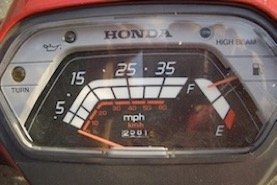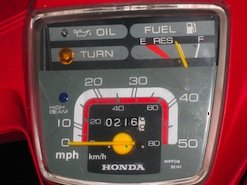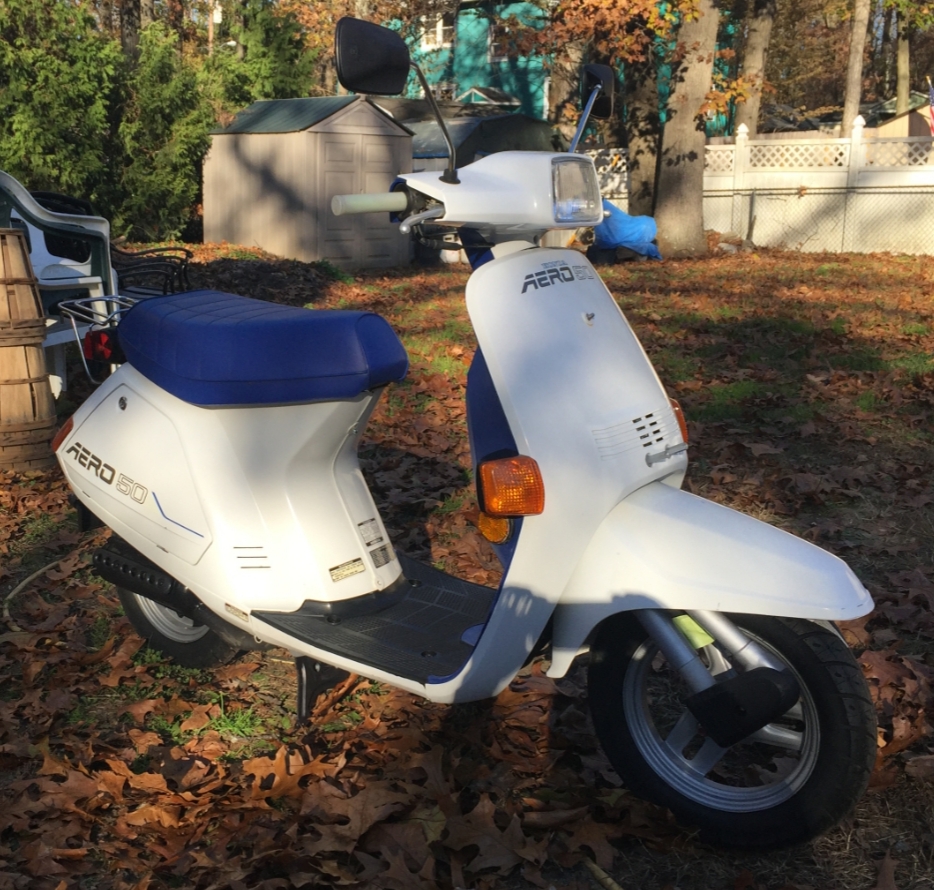HONDA AERO 50 (NB50)
The Aero 50 (NB50) was Honda’s first fully modern 50cc scooter sold in North America, thus completing the vision that started with the Express SR. Honda named this scooter the Aero 50 for the USA and Canadian markets, but elsewhere it received other names like Tact, Melody and Vision.
The NB50 was introduced in North America in 1983 (except Maryland) alongside it’s larger Aero 80 sibling. Initially costing just $619, the NB50 was sold until 1987 with a major update made for the 1985 model year using a new body design and motor. Both generations of the Aero 50 are peppy and well suited for around town use. The later model adds a great amount of storage with its glovebox (’85-’87 models) and storage in the right side panel (see the ad at the bottom of this page for a look inside).
Motors
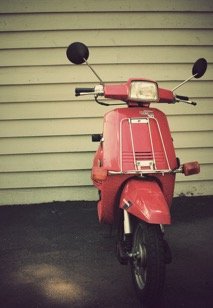
A properly running Aero 50 tops out at about 37-40mph and the ’85 to ’87 models can be modified to go quite a bit faster. Check out VTCycles.com for performance parts. In stock form, a properly running Aero 50 achieves at 60-65 mpg. The Aero 50 has a fairly small gas tank though (0.8 gal or 1.0 gal for later models) so range is limited. If you stop to fill it up as the fuel gauge dips into the red you are going to get about 0.6 – 0.8 gallons (2-3 litres). This corresponds to a range of 36 – 50 miles. That’s not really long distance touring material, but you could use the rear rack to carry a jerry can.
 Second Generation
Second Generation
Honda’s introduced a brand new generation of NB50 for 1985. The new design included an updated look, a new engine (AF05), a glovebox and a few other tweaks to make it more comfortable. Honda changed the style by removing the front rack, integrating the rear lights into the scooters’ body and by making the styling more ‘flowy’. Accordingly, all of the body panels are different.
To make the Aero 50 more comfortable, Honda added a plusher leading-link front suspension, in addition to wider bodywork and a bigger seat. Lastly, Honda replaced the existing ‘cubby hole’ storage spots on either side of the main frame tube with a proper locking glovebox. On the negative side, Honda ditched the kickstarter and the throttle controlled oil pump for ‘85 (both of which would return for ’86). The early style (’83 – ’84) is shown in the first two photos on this page, while the updated style is shown above left.
Honda also gave the gauges a full overhaul. Both generations are well laid out but the earlier setup wins the style award. The earlier gauges have a neat vintage look to them (below left) that is reminiscent of Honda’s mopeds, whereas the newer gauges (below right) are well laid out but have a less unique look.
Honda made a few changes for 1986 to the new (for ’85) engine. Most notably, Honda beefed up the crankshaft and changed the intake manifold and reed cage to a 4 bolt design. The ’86 intake manifolds use a different bolt pattern on the engine so you can’t switch between years. Honda also brought back the kickstarter and throttle controlled oil pump for ’86.
Performance Modifications
For performance, the 1986 and 1987 Aero 50’s are the best years because of their features and because of the potential to upgrade them to gain more speed. You can upgrade an ’85 with a big bore kit, but the different intake manifold pattern means that you are pretty much stuck with the stock carb, reeds and intake unless you get into custom work. For the ’86-’87 models you can get big bore kits up to 47mm bore (65cc), intakes, reeds, carbs and even gears. Top speeds in the 50-55mph range are possible. HondaSpree.net and ScooterSwapShop are the places to go if you want to learn more about this. The ’87 Elite 50 (SE50) and ’88-’93 Elite LX/SR (SA50) share a virtually identical engine, so you can use parts intended for these scooters as well. I believe only the intake manifold bolt pattern is different between the Aero 50 and these small Elite’s. The ’88-’90 ‘Elite E’ (SB50) is an entirely different animal so don’t use parts intended for that scoot.
Outside North American, Honda sold this scooter under a large number of names included ‘Tact’, ‘Lead 50’, ‘Melody Deluxe’, ‘Vision’ and ‘Vision-X’. In Japan, this scooter was first introduced for the 1980 model year as the Tact and it was revised for 1981 with the neat side panel storage. In the UK, Honda sold several different scooters under the Melody name but it was the ‘New Style Melody Deluxe’ introduced for 1984 that was virtually the same thing as the 1983 – 1985 Aero 50.
Discussion
If you’re looking for an affordable, peppy and reliable 2-stroke scoot, the Aero 50 is a great choice. You can often find examples with very low miles that have been in storage for years. These scooters are very reliable so all you may need to do is get some fresh gas and oil in it, change the plug, maybe clean the carb and get a new battery and you’ll be set for years of fairly reliable scootering. There may be other problems depending on how it was stored and treated but once you sort these out, it should be a reliable scooter. The great thing about buying an 80’s Japanese scooter is that they sell for way less than an Italian scooter does since you aren’t paying for the name or collectors value. Normally, a non-running Aero 50 will sell for $100-$400 and an Aero 50 in good running condition will sell for $500-$900. You can still get many of the OEM parts for these scooters and the discontinued parts can be found with a bit of work on sites like eBay. Finding the right parts can be half the fun.
Honda sold a decent assortment of accessories for the Aero 50 including a windscreen, a ‘Music Pak’ (fanny pack), a rear ‘tote box’, a rubber floor mat, wire and mesh front baskets, a front ‘box’, a rear wire basket, a seat cover, body cover, decal and stripe kits and a front rack for the ’85-’87 models that didn’t with one. As you can imagine, it’s possible to equip your Aero 50 with a remarkable amount of storage space.
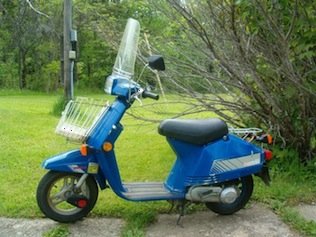
Overall, the Aero 50 is an awesome scooter. It’s stylish, reliable, peppy and it has great storage capacity. If you’re buying one, keep an eye open for the updated ’85 – ’87 version because it has a glove box and you can buy aftermarket performance parts for it, but if you plan on keeping your motor stock then you might prefer an earlier model because they do have some sweet vintage style. The Aero 50 has a enduring look that has held up better than the 2-stroke 50’s that followed it in the later 80’s and 90’s (ie. Honda Elite 50/SR, Yamaha Jog). Since they can be had so affordably, an Aero 50 makes sense for anyone who doesn’t mind turning a wrench occasionally to keep their vintage machine purring.
Pros:
- Great storage (especially ’85-’87)
- Peppy
- Performance parts available (’85 – ’87)
- Honda reliability
Cons:
- No room for a passenger
- Dwindling OEM part availability
- No kickstarter for ’85 models
- 60-65 mpg is only mediocre
Links:
’83-’84 Service Manual – Valuable info for wrenching on your Aero 50
’85-’87 Service Manual – These Honda manuals are amazing. Download this.
HondaSpree.net – An awesome community for all small Honda scooters.
Aero 50 Ads and Brochure Scans – Neat stuff from the creative minds at Honda in the 80’s.
MotorscooterGuide Forums – Visit the forum on this site to chat about this scoot.
ScooterSwapShop – Aftermarket goodies
ScooterTuning.ca – An online scooter shop with many Aero parts
For a better look at an Aero 50, watch this video.
Key Specs (’83 – ’84 model):
- Engine: Forced-air-cooled 49cc two-stroke with automatic oil injection
- Transmission: Honda V-matic variable ratio with automatic clutch
- Bore & Stroke: 40 mm x 39.3 mm (’83 – ’84)
- Compression Ratio: 7.2:1
- Carb: 14mm slide carb
- Drive: Belt
- Starter: Electric and kick
- Seat Height: 27.2”
- Length: 63.0” / 1600mm
- Width: 24.8” / 630mm
- Height: 37.8” / 960mm
- Wheelbase: 44.1” / 1120mm
- Dry Weight: 125 lbs
- Engine Weight: 33.5 lbs / 15.2 kg
- Spark Plug: NGK BPR6HS
- Alternator: 89W @ 5000 RPM
- Fuel Tank: 3.2L / 0.85 US Gallons
- Brakes: Drum / Drum
- Front Suspension: Leading link, 55mm (2.16″) travel
- Rear Suspension: Swing unit, single damper, 60mm (2.36″) travel
- Tires: 2.75-10 4PR (Front and Rear)
- Final Reduction Ratio: 7.978:1
- Honda Accessories: Rear case, front basket, windscreen
- MSRP: $618 (1984)
Key Specs (’85 – ’87 model):
- Engine: Forced-air-cooled 49.3cc two-stroke with automatic oil injection
- Transmission: Honda V-matic variable ratio with automatic clutch
- Bore & Stroke: 41 mm x 37.4mm
- Compression Ratio: 6.8:1
- Power: 3.9hp @ 6000 RPM, 3.5 lbs-ft torque @ 5000 RPM
- Drive: Belt
- Starter: Electric and kick (no kick on ’85 models)
- Length: 62.8” / 1595mm
- Width: 24.6” / 625mm
- Height: 38.0” / 965mm
- Wheelbase: 44.5” / 1130mm
- Dry weight: 121.3 lbs / 55 kg
- Max Load: 180 lbs / 82 kg
- Engine Weight: 30.9 lbs / 14 kg
- Alternator Capacity: 96W @ 5000 RPM
- Final Reduction Ratio: 11.097:1
- Seat height: 27.2” / 690mm
- Spark Plug: NGK BPR6HS (changed to BPR6HSA for 1986).
- Fuel Tank: 3.7 L / 1.0 US gallons
- Brakes: Drum / Drum
- Front Suspension: Trailing bottom link, 43mm (1.7″) travel
- Rear Suspension: Swing unit, single damper, 60mm (2.36″ travel)
- Tires: 2.75-10 4PR (Front and Rear)
- Honda Accessories: Rear case, front basket, windscreen
Colors:
- 1983 – Monza Red (R110), Percian Blue (B104)
- 1984 – Berry Glow Red (R133), Neptune Blue (PB109), Shiny Orange (Canada)
- 1985 – Monza Red (R110), Black (NH1), Omega Red (R139)
- 1986 – Black (NH1), Omega Red (R139), Shasta White (NH138), April Blue (PB147)
- 1987 – Monza Red (R110), Shasta White (NH138)
In North America, most black Aero 50’s had red seats, red ones had grey seats and the white ones had blue seats.

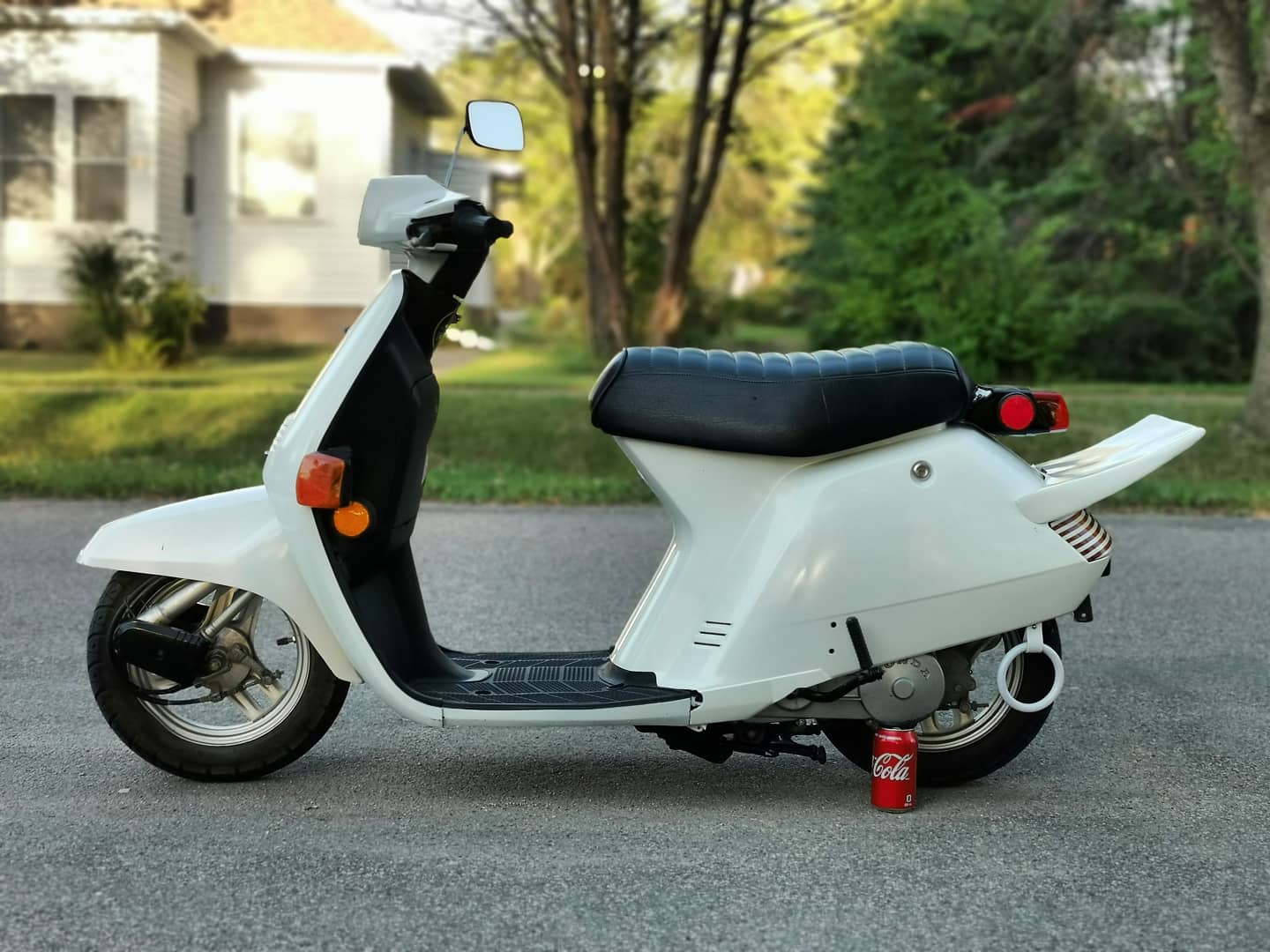
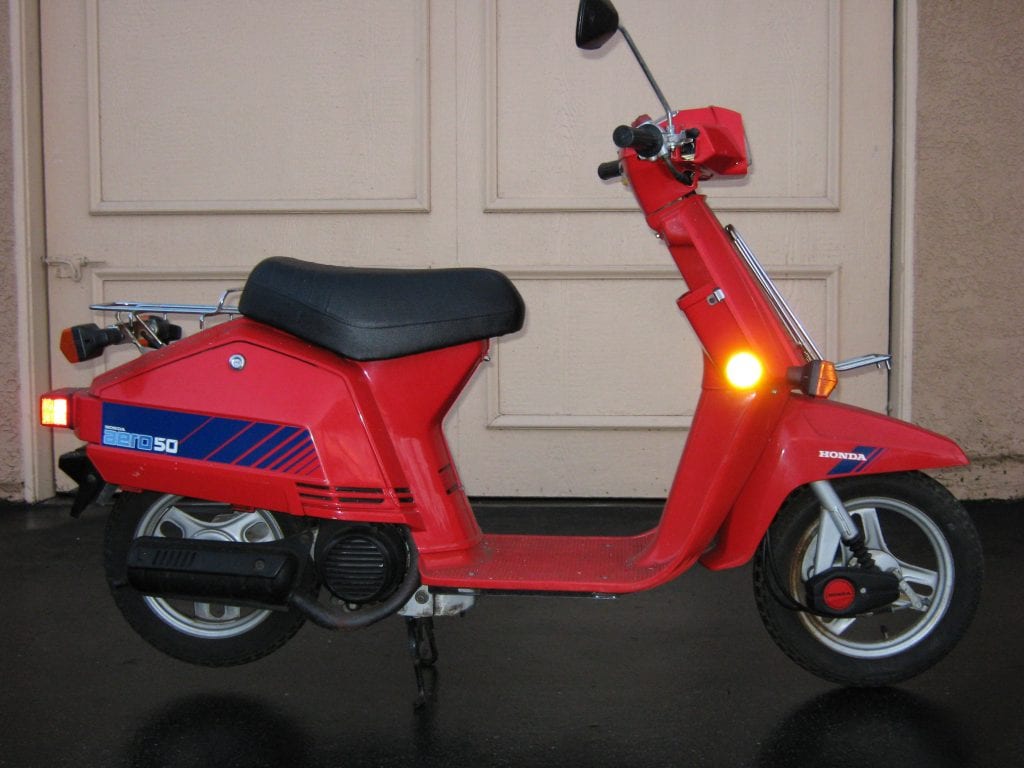
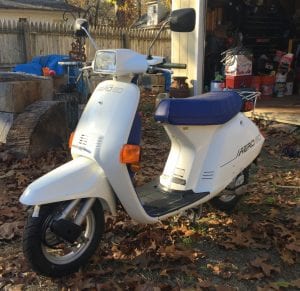 Second Generation
Second Generation